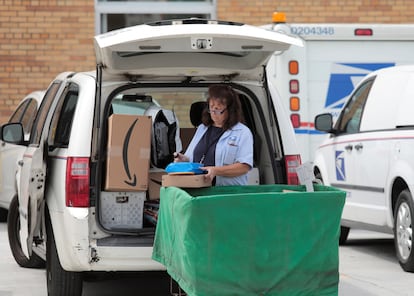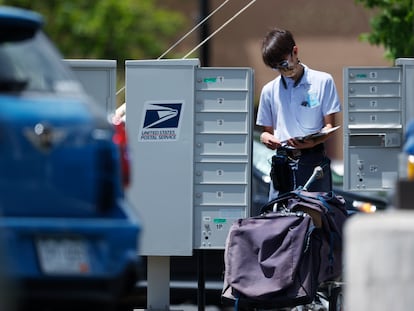Postal Service, once chided for slow adoption of EVs, announces plan to cut greenhouse gas emissions
The Postal Service intends to save $5 billion by consolidating smaller facilities into larger sorting and processing hubs that eliminate thousands of trips a day

The U.S. Postal Service announced sweeping plans Tuesday to reduce greenhouse emissions by diverting more parcels from air to ground transportation, boosting the number of electric vehicles, cutting waste sent to landfills and making delivery routes more efficient.
Postmaster General Louis DeJoy described a mix of environmental initiatives and cost-cutting business practices that together would combine to reduce the Postal Service’s contribution to planet-warming greenhouse gas emissions by 40% over five years, meeting the Biden administration environmental goals in the process.
“We reduce costs, we reduce carbon. It’s very much hand in hand,” said DeJoy, who acknowledged being impatient with the pace of change, including the rollout of electric vehicles.
All told, the Postal Service intends to save $5 billion by consolidating smaller facilities into larger sorting and processing hubs that eliminate thousands of trips a day, along with operational changes such as modernizing facilities and reducing outsourced work, officials said.
Those efficiency-driven changes will help the environment by reducing carbon emissions by eliminating wasteful activities, in addition to electric vehicles and other efforts.
“These initiatives represent the strongest and most aggressive actions the Postal Service has ever taken to reduce greenhouse gas emissions,” said Jennifer Beiro-Réveillé, the organization’s senior director of environmental affairs and corporate sustainability.
The Postal Service’s announcement follows criticism that it was moving too slowly in reducing emissions from one of the largest fleets of civilian vehicles in the world.
But efforts picked up steam after the approval of $3 billion in funding for electric vehicles and charging infrastructure under a landmark climate and health policy adopted by Congress.
Last month, the Postal Service unveiled new EVs and charging stations at a new distribution center in Georgia, one of many updated sorting and delivery centers that are opening. Workers may have to drive farther to work at a new facility, but there are no plans to cut jobs, DeJoy said.
The Postal Service plans to take delivery of 66,000 electric vehicles over five years. That includes about 10,000 vehicles from Ford this year and a handful of next-generation delivery vehicles by year’s end from Oshkosh, which won a contract to convert the fleet of aging vehicles. The bulk of the deliveries from Oshkosh won’t come until the 2026-2028 period, he said.
Postal carriers have been soldiering on with overworked delivery trucks that went into service between 1987 to 1994. But not everyone is thrilled by the focus on electric vehicles.
Craig Stevens, chair of a group called Grow America’s Infrastructure Now, questioned the cost of EVs and infrastructure. He also cast doubt on their effectiveness in colder climates, citing a recent bout of extreme cold in the Midwest that hampered EVs there.
“How will Americans living in cold climates rely on the USPS if their delivery trucks don’t work in cold weather?” he wrote in a statement.
Sign up for our weekly newsletter to get more English-language news coverage from EL PAÍS USA Edition
Tu suscripción se está usando en otro dispositivo
¿Quieres añadir otro usuario a tu suscripción?
Si continúas leyendo en este dispositivo, no se podrá leer en el otro.
FlechaTu suscripción se está usando en otro dispositivo y solo puedes acceder a EL PAÍS desde un dispositivo a la vez.
Si quieres compartir tu cuenta, cambia tu suscripción a la modalidad Premium, así podrás añadir otro usuario. Cada uno accederá con su propia cuenta de email, lo que os permitirá personalizar vuestra experiencia en EL PAÍS.
¿Tienes una suscripción de empresa? Accede aquí para contratar más cuentas.
En el caso de no saber quién está usando tu cuenta, te recomendamos cambiar tu contraseña aquí.
Si decides continuar compartiendo tu cuenta, este mensaje se mostrará en tu dispositivo y en el de la otra persona que está usando tu cuenta de forma indefinida, afectando a tu experiencia de lectura. Puedes consultar aquí los términos y condiciones de la suscripción digital.
More information
Archived In
Últimas noticias
Trump claims peace in Ukraine is near, but Moscow suggests otherwise
A survivor’s account of the Interoceanic Train accident: ‘We were scared because of the speed on the curve’
The Interoceanic Train, the Mexican alternative to the Panama Canal
What is known about the Interoceanic Train derailment in Oaxaca
Most viewed
- Oona Chaplin: ‘I told James Cameron that I was living in a treehouse and starting a permaculture project with a friend’
- Reinhard Genzel, Nobel laureate in physics: ‘One-minute videos will never give you the truth’
- Why the price of coffee has skyrocketed: from Brazilian plantations to specialty coffee houses
- Pablo Escobar’s hippos: A serious environmental problem, 40 years on
- Chevy Chase, the beloved comedian who was a monster off camera: ‘Not everyone hated him, just the people who’ve worked with him’










































